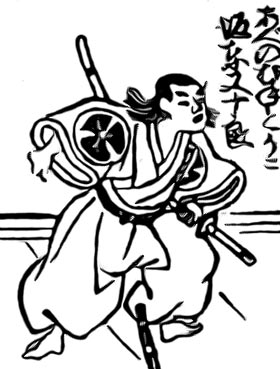| BANDď MATAJ█Rď I |
|
Stage names:
Line number: SHODAI (I) Existence: ??? ~ ??? Connection: Masters: Band˘ Matakur˘ II (?), Sodesaki Karyű (?) Career: 11th lunar month of 1693: first-recorded performance in Ky˘to; this wakaonnagata was most likely a disciple of Sodesaki Karyű and his stage name was Sodesaki Chisato. 1695: he went to Edo to perform at the Moritaza, where he took the name of Uemura Sagenta (relation to the Uemura clan unknown). 11th lunar month of 1696: Sagenta played at the Moritaza the role of Akashi-no-Mae in the drama "Shitenn˘ Yome Kagami". 1st lunar month of 1700: he became tachiyaku, most likely disciple of Band˘ Matakur˘ II, and took the name of Band˘ Sawaemon at the Moritaza, playing the role of Hachiman Tar˘ in the new year drama "Kagemasa Ikazuchi Mond˘". Fall 1705: Sawaemon went to Ky˘to. 11th lunar month of 1705: Band˘ Sawaemon took the name of Band˘ Matajűr˘ I in Ky˘to at Miyako Mandayű's theater. Fall 1706: Matajűr˘ went to ďsaka. 11th lunar month of 1706: he became katakiyaku and played the role of Ikegami Hasunoj˘ in the kaomise drama "Shinpan Honma Ky˘gen", which was produced by Iwai Hanshir˘ II. 1st lunar month of 1708: Matajűr˘'s rank in the ďsaka hy˘banki, katakiyaku section, was j˘-j˘-(shiro)kichi (superior - superior - (white) excellent) [visual]. 11th lunar month of 1708: Matajűr˘ became jitsuaku and performed in ďsaka in the kaomise drama "Tate Eboshi Daijin Bashira", which was produced by Arashi Sanjűr˘ I. 3rd lunar month of 1709: Matajűr˘'s rank in the ďsaka hy˘banki, jitsuaku section, was j˘ (superior) [visual]. 11th lunar month of 1709: Matajűr˘ performed in ďsaka in the kaomise drama "Mai˘gi Masaki no Kazura", which was produced by Ogino Yaegiri I. 3rd lunar month of 1710: Matajűr˘'s rank in the ďsaka hy˘banki, jitsuaku section, was j˘-(shiro)j˘ (superior - (white) superior) [visual]. 11th lunar month of 1710: Matajűr˘ performed in ďsaka in the kaomise drama "Sasaki Uji ďshimadai", which was produced by Sakakiyama Shirotar˘ I. 3rd lunar month of 1711: Matajűr˘'s rank in the ďsaka hy˘banki, jitsuaku section, was j˘-j˘ (superior - superior) [visual]. Fall 1715: Matajűr˘ went to Ky˘to. 11th lunar month of 1715: Matajűr˘ became tachiyaku and performed in the kaomise drama "Chiyogasane Kiku no Shinpai", which was produced by Yamatoyama Jinzaemon I for the nadai Hayagumo Ch˘dayű. 11th lunar month of 1717: Matajűr˘ played the role of ďtomo no Kuronushi in Sakakiyama Kansuke I's kaomise drama "ďmu Gaeshi Momotose Gitsune", which was produced by Sakakiyama Shirotar˘ I at Hayagumo Ch˘dayű's theater; his stage partners were Shibazaki Rinzaemon I, Kirinami Takie, Yamada Jinpachi, Band˘ Hikosabur˘ I, Sawamura Otoemon I, Sakakiyama Koshir˘ I, Katayama Kozaemon, Matsushima Moheiji and Onoe Samon. 11th lunar month of 1719: Matajűr˘ became jitsuaku and played the role of Wadanohara Tatewaki in the kaomise drama "H˘raisan Hiyoku no Tsurukame", which was produced by Yamatoyama Jinzaemon I for the nadai Ebisuya Kichir˘bŕ. Fall 1721: Matajűr˘ went to ďsaka. 11th lunar month of 1721: Matajűr˘ played at the Naka no Shibai in the kaomise drama "Onna Genji Musha Sugoroku", which was produced by Takeshima K˘zaemon II. 11th lunar month of 1722: Matajűr˘ played at the ďnishi no Shibai the role of Kumagushi D˘kan in the kaomise drama "Genji Moy˘ Ichimai Gushi", which was produced by Yamatoyama Jinzaemon II (who celebrated his shűmei). Fall 1728: Matajűr˘ went to Ky˘to. 11th lunar month of 1728: Matajűr˘ became katakiyaku and performed in the kaomise drama "Daimy˘ Kogane no Uroko", which was produced by Sanogawa Mangiku at Hayagumo Ch˘dayű's theater. Fall 1730: Matajűr˘ went to Edo. 11th lunar month of 1730: Matajűr˘ played at the Moritaza the role of Abe no Munet˘ in the kaomise drama "Kankatsu Michinoku no Miyako". 1st lunar month of 1734: Matajűr˘ played at the Moritaza the role of Kajiwara in the new year drama "Harukoma Kan˘ Soga"; this was his last-recorded stage performance. We don't know what happens to him afterwards. His last ranking in the Edo hy˘banki, katakiyaku section, was j˘-(shiro)j˘ (superior - (white) superior) [visual].
Comments: Band˘ Matajűr˘ I was a versatile actor, who was active in Kamigata and Edo from the beginning of the 1690s to the middle of the 1730s. He was trained as an onnagata but switched to male roles in 1700 and performed either as a tachiyaku, katakiyaku or jitsuaku. |
 |
|
Band˘ Matajűr˘ I playing the role of Abe no Munet˘ in the kaomise drama "Kankatsu Michinoku no Miyako", which was staged in the 11th lunar month of 1730 at the Moritaza The Band˘ Matajűr˘ line of actors |
|
|
| Contact | Main | Top | Updates | Actors | Plays | Playwrights | Programs | Links | FAQ | Glossary | Chronology | Illustrations | Prints | Characters | Derivatives | Theaters | Coming soon | News |